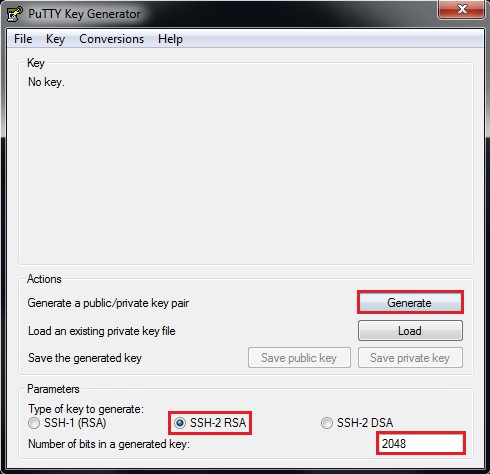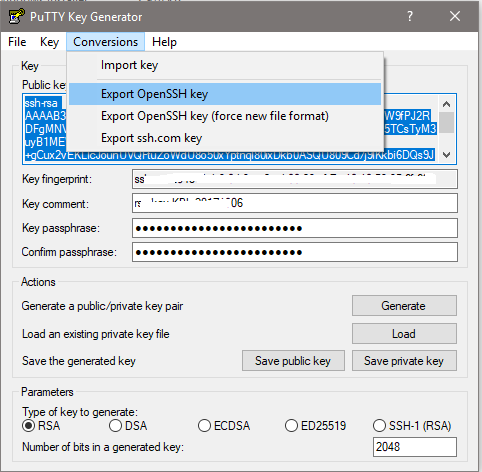

ssh-keygen -t ed25519Įxtracting the public key from an RSA keypair openssl rsa -pubout -in private_key.pem -out public_key.pemĮxtracting the public key from an DSA keypair openssl dsa -pubout -in private_key.pem -out public_key.pem Generate an ed25519 SSH keypair- this is a new algorithm added in OpenSSH. Generate an ECDSA SSH keypair with a 521 bit private key ssh-keygen -t ecdsa -b 521 -C "ECDSA 521 bit Keys" Generate an DSA SSH keypair with a 2048 bit private key ssh-keygen -t dsa -b 1024 -C "DSA 1024 bit Keys" Generate an RSA SSH keypair with a 4096 bit private key ssh-keygen -t rsa -b 4096 -C "RSA 4096 bit Keys" Ssh-keygen authentication key generation, management and conversion
CONVERT OPENSSH PRIVATE KEY TO RSA SOFTWARE
A Layman’s Guide to a Subset of ASN.1, BER, and DERīasically, ASN.1 is a standard for describing abstract data types, and DER is a set of rules for transforming an ASN.1 data type into a series of octets.Thanks for using this software, for Cofee/Beer/Amazon bill and further development of this project please Share.Īny private key value that you enter or we generate is not stored on this site, this tool is provided via an HTTPS URL to ensure that private keys cannot be stolen, for extra security run this software on your network, no cloud dependencyĪsking for donation sound bad to me, so i'm raising fund from by offering all my Nine book for just $9. The WikiPedia entry for Distinguished Encoding Rules. The data in a PKCS#1 key is encoded using DER, which is a set of rules for serializing ASN.1 data. The x.509 format may be used to store keys generated using algorithms other than RSA. This is different from an x.509 public key, which looks like this: -BEGIN PUBLIC KEY. You can identify a PKCS#1 PEM-encoded public key by the markers used to delimit the base64 encoded data: -BEGIN RSA PUBLIC KEY. PKCS#1 is “the first of a family of standards called Public-Key Cryptography Standards (PKCS), published by RSA Laboratories.” ( Wikipedia). Our target format is a PEM-encoded PKCS#1 public key. The next step is to produce the appropriate output format. There may be better ways to do this, but this works: e_val = eval('0x' + ''.join( for x in We need to convert the character buffers currently holding e (the exponent) and n (the modulus) into numeric types. This leaves us with an array that, for an RSA key, will look like: # get the second field from the public key file.ĭlen = struct.unpack('>I', keydata)ĭata, keydata = keydata, keydata We can read this in with the following Python code: import sys This duplicates the key type in the first field of the public key.įor more information on how RSA works and what the exponent and modulus are used for, read the Wikipedia article on RSA. algorithm name (one of (ssh-rsa, ssh-dsa)). The length is encoded as four octets (in big-endian order). What, you may ask, is PEM encoding? Privacy Enhanced Mail (PEM) is a specific type of Base64 encoding…which is to say it is a way of representing binary data using only printable ASCII characters.įor an ssh-rsa key, the PEM-encoded data is a series of (length, data) pairs. Briefly, an OpenSSH public key consists of three fields: The OpenSSH public key format is fully documented RFC 4253. If you have a recent version of OpenSSH (where recent means 5.6 or later), you can just do this: ssh-keygen -f key.pub -e -m pem QSYlFuShWrHPtiLmUdPoP6CV2mML1tk+l7DIIqXrQhLUKDACeM5roMx0kLhUWB8P MwSXA9VNmhz+PiB+Dml4WWnKW/VHo2ujTXxq7+efMU4H2fn圓Se3KYOsFPFGZ1TN +xTBtWdEo7XGUujKDvC2/aZKukfjpOiUI8AhLAfjmlcD/UZ1QPh0mHsglRNCmpCw 
MIIBCgKCAQEA+xGZ/wcz9ugFpP07Nspo6U17l0YhFiFpxxU4pTk3Lifz9R3zsIsuĮRwta7+fWIfxOo208ett/jhskiVodSEt3QBGh4XBipyWopKwZ93HHaDVZAALi/2A

JiUW5KFasc+2IuZR0+g/oJXaYwvW2T6XsMgipetCEtQoMAJ4zmugzHSQuFRYHw/7S6PUI2UĠ3glFmULvEV+qIxsVFT1ng3pj this: -BEGIN RSA PUBLIC KEY. HFTilOTcuJ/P1HfOwiy4RHC1rv59Yh/E6jbT圆23+OGySJWh1IS3dAEaHhcGKnJaikrBn3cĬdoNVkAAuL/YD7FMG1Z0SjtcZS6MoO8Lb9pkq6R+Ok6JQjwCEsB+OaVwP9RnVA+HSYe圜VEĠKakLCbBJcD1U2aHP4+IH4OaXhZacpb9Ueja6NNfGrv558xTgfZ+fLdJ7cpg6wU8UZnVM1B That is, I wanted to go from this: ssh-rsa AAAAB3NzaC1yc2EAAAADAQABAAABAQD7EZn/BzP26AWk/Ts2ymjpTXuXRiEWIWn I’ve posted a followup to this article that discusses ssh-agent.įor reasons best left to another post, I wanted to convert an SSH public key into a PKCS#1 PEM-encoded public key.







 0 kommentar(er)
0 kommentar(er)
